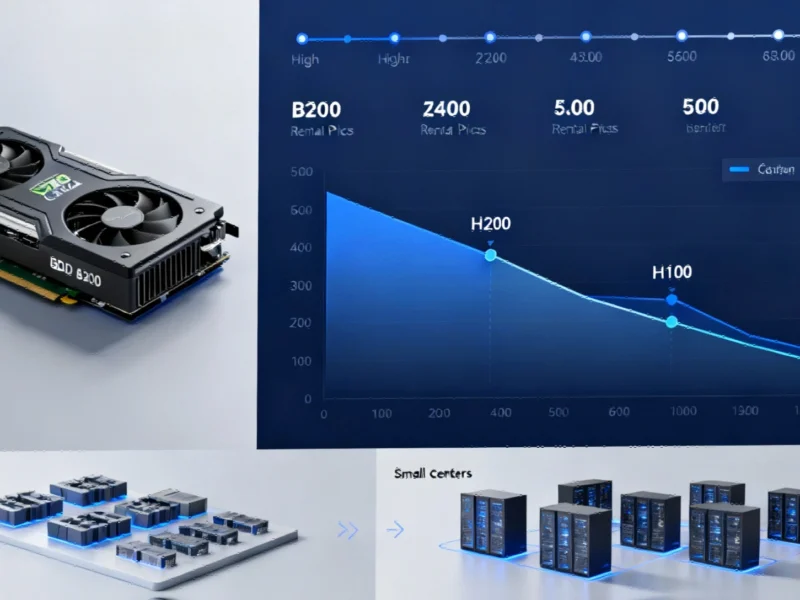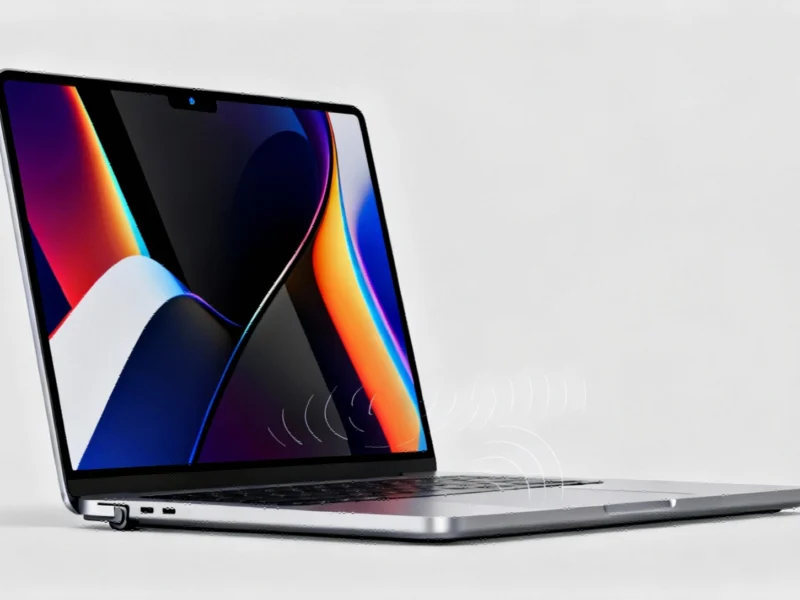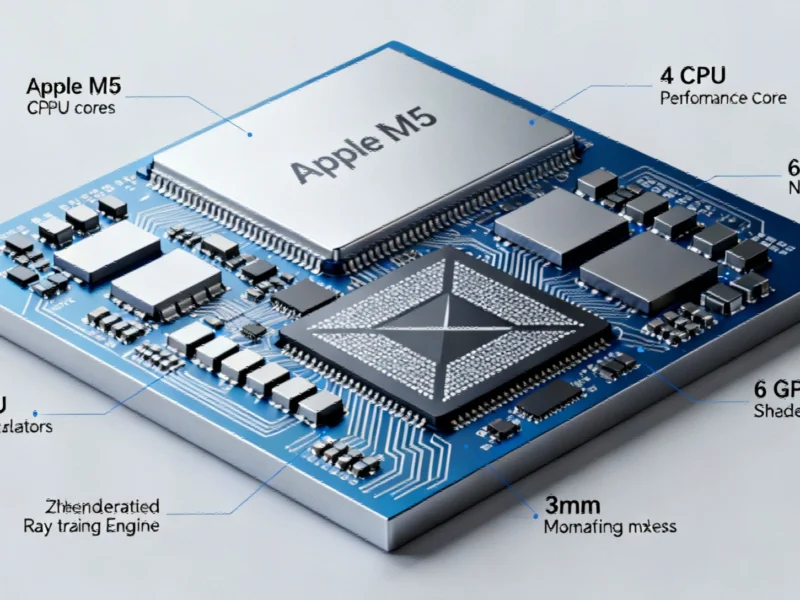The Great GPU Divide: How Rental Markets Predict AI’s Coming Shakeout
The artificial intelligence industry is experiencing a peculiar paradox: while AI hardware costs continue to plummet for some users, the underlying economics reveal troubling signs for the sector’s sustainability. The recent intensifying GPU rental price wars have created a fragmented market where hyperscalers and smaller providers operate in entirely different realities, signaling potential trouble ahead for the much-hyped AI revolution.
Consider the trajectory of Nvidia’s flagship processors. The B200 GPU accelerator, which commanded approximately $500,000 upon its late-2024 release, now rents for as little as $2.80 per hour—a staggering 99.999% discount from its purchase price when calculated over a typical usage period. This dramatic depreciation isn’t merely a story of technological progress; it’s a window into the fundamental economics threatening to destabilize the AI ecosystem.
The Hyperscaler Shield: Why Big Players Resist Price Erosion
While average GPU rental prices have declined significantly—H200 and H100 chips down 29% and 22% respectively year-to-date—the hyperscaler quadrant of Amazon AWS, Microsoft Azure, Google Cloud, and Oracle has maintained remarkable price stability. This creates an ever-widening chasm between what the industry giants charge versus emerging competitors.
The pricing disparity reflects two distinct customer bases with fundamentally different needs. AI startups and research institutions, historically the core GPU-as-a-service clients, require massive computing power for limited durations to train new models. For these users, staying within the hyperscaler ecosystem offers continuity, security, and efficiency benefits that justify premium pricing.
Meanwhile, corporate customers seeking AI implementations increasingly bypass GPU rentals altogether, opting instead for pre-built solutions from providers like OpenAI or Anthropic that charge by the token rather than compute hour. This migration has left smaller GPU providers scrambling for whatever business remains.
The Bottom-Feeder Economy: Who’s Left at $0.40 Per Hour?
The RBC Capital Markets data reveals a disturbing reality: while hyperscalers continue charging over $4 per hour for legacy A100 chips, some competitors have slashed prices to as low as $0.40 per hour. At these rates, the math becomes increasingly difficult to justify.
Using simplified calculations, an Nvidia A100 purchased for $199,000 in 2020 would need to generate approximately $4 per hour over its five-year lifespan to break even at 100% utilization. With current market rates falling to $1.65 average—and far lower at the bottom—many providers are operating at unsustainable losses.
The customer base willing to patronize these discount services has narrowed considerably. What remains are what industry insiders call “the dregs”: industrial operations with minimal quality requirements, underfunded academic projects, aspiring quantitative hedge funds, virtual character developers, and hobbyists pursuing niche applications. As broader market uncertainties continue affecting technology investments, these marginal customers may not provide sufficient revenue to sustain the infrastructure.
The Strategic Calculus: Predatory Pricing or Market Evolution?
From a distance, the GPU rental market appears to be following the classic tech industry playbook: burn capital to eliminate competition, then dominate the market. However, the evidence suggests a more complex dynamic.
Hyperscalers appear to be betting that their integrated ecosystems—combining compute, storage, networking, and specialized AI services—will retain premium customers regardless of raw GPU pricing. This strategy mirrors Microsoft’s approach with AI-integrated Windows, where the value proposition extends far beyond individual component costs.
Meanwhile, smaller providers face the brutal arithmetic of infrastructure economics. With Nvidia updating its chip architecture every two years, the depreciation curve becomes increasingly steep. The current pricing environment suggests that many second-tier providers may lack the financial resilience to survive until the next upgrade cycle.
Broader Implications: AI’s Hardware Dependency Problem
The GPU pricing collapse intersects with several concerning trends in the AI sector. As OpenAI moves toward vertical integration, controlling more of the AI stack from chips to applications, the standalone GPU rental business model faces additional pressure.
Similarly, the infrastructure challenges aren’t limited to compute resources. As network security concerns grow alongside AI adoption, the total cost of operation extends far beyond GPU rentals alone. These ancillary requirements further advantage hyperscalers with comprehensive service portfolios.
The international dimension adds another layer of complexity. As trade tensions affect technology supply chains, the stability of GPU pricing and availability faces additional geopolitical risks that could accelerate market consolidation.
The Coming Consolidation: What Survives the Shakeout?
The current GPU rental market resembles multiple industries approaching inflection points: unsustainable pricing, diverging customer bases, and increasing infrastructure costs. The likely outcome is significant market consolidation, with several possible scenarios emerging.
First, hyperscalers may continue their premium positioning while acquiring distressed competitors at bargain prices during the downturn. Second, specialized providers might survive by catering to niche markets with unique requirements that hyperscalers cannot efficiently serve. Finally, the entire GPU rental model might evolve toward more hybrid approaches, combining dedicated hardware with shared resources.
What remains clear is that the current fragmentation cannot persist indefinitely. As the gap between hyperscaler pricing and discount providers widens, and as break-even calculations become increasingly challenging for smaller operators, the AI hardware ecosystem appears headed for significant restructuring. The GPU price collapse isn’t merely a market adjustment—it’s a leading indicator of the AI industry’s coming maturation and the inevitable shakeout that follows technological hype cycles.
Based on reporting by {‘uri’: ‘ft.com’, ‘dataType’: ‘news’, ‘title’: ‘Financial Times News’, ‘description’: ‘The best of FT journalism, including breaking news and insight.’, ‘location’: {‘type’: ‘place’, ‘geoNamesId’: ‘2643743’, ‘label’: {‘eng’: ‘London’}, ‘population’: 7556900, ‘lat’: 51.50853, ‘long’: -0.12574, ‘country’: {‘type’: ‘country’, ‘geoNamesId’: ‘2635167’, ‘label’: {‘eng’: ‘United Kingdom’}, ‘population’: 62348447, ‘lat’: 54.75844, ‘long’: -2.69531, ‘area’: 244820, ‘continent’: ‘Europe’}}, ‘locationValidated’: True, ‘ranking’: {‘importanceRank’: 50000, ‘alexaGlobalRank’: 1671, ‘alexaCountryRank’: 1139}}. This article aggregates information from publicly available sources. All trademarks and copyrights belong to their respective owners.



